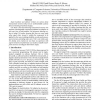CACM
2008
14 years 16 days ago
2008
TxLinux is the first operating system to use hardware transactional memory (HTM) as a synchronization primitive, and the first to manage HTM in the scheduler. TxLinux, which is a ...
MASCOTS
2010
14 years 1 months ago
2010
In this paper, we develop a queuing theory based analytical model to evaluate the performance of transactional memory. Based on the statistical characteristics observed on actual e...
DAGSTUHL
2007
14 years 1 months ago
2007
Major hardware and software vendors are curious about transactional memory (TM), but are understandably cautious about committing to hardware changes. Our thesis is that deconstru...
CONCUR
2008
Springer
14 years 2 months ago
2008
Springer
Abstract. Dynamic separation is a new programming discipline for systems with transactional memory. We study it formally in the setting of a small calculus with transactions. We pr...
ISPASS
2010
IEEE
14 years 2 months ago
2010
IEEE
Abstract—Transactional memory promises to generalize transactional programming to mainstream languages and data structures. The purported benefit of transactions is that they ar...
HIPEAC
2010
Springer
14 years 2 months ago
2010
Springer
The optimistic nature of Transactional Memory (TM) systems can lead to the concurrent execution of transactions that are later found to conflict. Conflicts degrade scalability, a...
HOTOS
2009
IEEE
14 years 4 months ago
2009
IEEE
Operating systems can efficiently provide system transactions to user applications, in which user-level processes can execute a series of system calls atomically and in isolation ...
PODC
2010
ACM
14 years 4 months ago
2010
ACM
Concurrent collection classes are widely used in multi-threaded programming, but they provide atomicity only for a fixed set of operations. Software transactional memory (STM) pr...
ISCA
1993
IEEE
14 years 4 months ago
1993
IEEE
A shared data structure is lock-free if its operations do not require mutual exclusion. If one process is interrupted in the middle of an operation, other processes will not be pr...
WDAG
2005
Springer
14 years 6 months ago
2005
Springer
Transactional Memory is a concurrent programming API in which concurrent threads synchronize via transactions (instead of locks). Although this model has mostly been studied in the...




